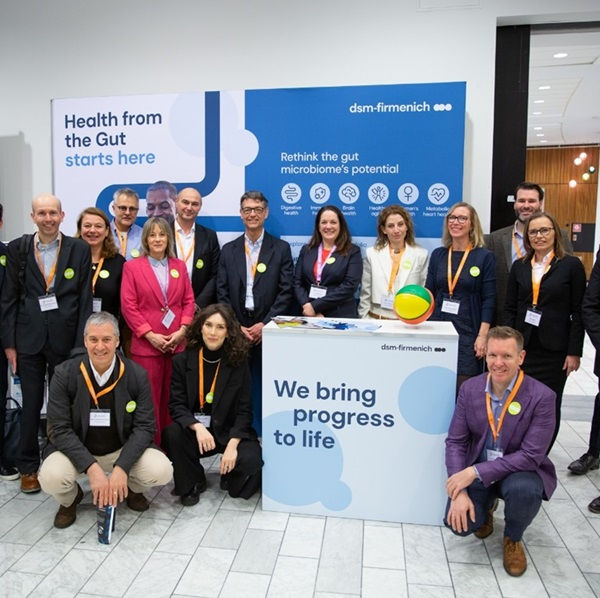News
August 15, 2023
Sustainable DHA and ARA lipids for infants
Discover the benefits of dsm-firmenich’s life’sDHA® and life’sARA® nutritional lipids for infant and maternal nutrition, sustainably sourced from plants.

Summary
- The nutritional lipids docosahexaenoic acid (DHA) and arachidonic acid (ARA) are important building blocks for a healthy start in life, supporting infant cognitive and visual development, as well as immunity, bone health and more. i,ii,iii,iv,v,vi
- There is a growing need for convenient and sustainable plant-based nutritional lipids that support maternal and infant health, without compromising the health of our planet.
- Read our blog to discover dsm-firmenich’s portfolio of 100% plant-based nutritional lipids that deliver the essential health benefits of DHA and ARA with zero impact on marine ecosystems.
Getting the right nutrition is important across the lifespan, but it’s particularly crucial for women of childbearing age and for infants during the first 1,000 days of life. It is well recognized that – from preconception through to a child’s second birthday – nutritional lipids play a pivotal role in health and development, including the long-chain polyunsaturated fatty acids, omega-3 docosahexaenoic acid (DHA) and omega-6 arachidonic acid (ARA). Read on to explore how dsm-firmenich’s sustainable DHA and ARA solutions can help give babies the best possible start in life.
The role of omega-3 DHA: from conception to motherhood
Lipids, specifically DHA, play a role in early life nutrition before an infant is even conceived. Emerging evidence suggests that adequate omega-3 DHA intake among women undergoing assisted reproduction may potentially increase the likelihood of a successful conception and help prepare the body for a healthy pregnancy.vii,viii DHA accumulates rapidly in the fetal brain and plays a fundamental role in early brain development. A recent systematic review reported that DHA intakes during pregnancy are positively associated with neurodevelopmental outcomes in infants and children.ix Moreover, a Cochrane review found that the addition of DHA during pregnancy reduces the risk of preterm birth by 11% and early preterm birth by 42%.x In addition, recent clinical trials have found that women with adequate DHA intake early in pregnancy are at a reduced risk of preterm and early preterm births, suggesting that supplementation with DHA prior to becoming pregnant may be protective.xi,xii
Omega-3s are not only important for babies, but for mothers too. While pregnancy and motherhood are an exciting time, perinatal mood and anxiety disorders are extremely prevalent and one of the most common complications of pregnancy.xiii However, omega-3s yet again show huge promise in this space, with research indicating DHA can potentially support and maintain a healthy, balanced mood for women during pregnancy and after giving birth.xiv,xv,xvi
Supporting infant development with DHA and ARA
DHA and ARA are both found naturally in breastmilk – the gold standard in infant nutrition – typically with ARA levels higher than those of DHA.xvii,xviii However, EU regulations made in 2020 outline that only DHA is a mandatory ingredient for infant formula, leaving ARA as optional. This has caused controversy throughout the infant nutrition market, largely due to the lack of scientific evidence demonstrating the safety of supplying DHA alone. Experts strongly believe that infant nutrition formulators should follow existing scientific knowledge – that is to base infant nutrition formulations on the composition of human milk and include both DHA and ARA.
Both DHA and ARA accumulate in the brain and support almost every area of brain function as an infant grows including mental adaptability and problem solving, as well as attention and information processing. DHA and ARA have also been shown to have positive effects on visual development when provided together and in efficacious levels during pregnancy and throughout infancy.
There is growing evidence for the combined role of DHA and ARA in the developing immune system, as well as the role of ARA in healthy bone formation, blood flow and blood vessel formation. As such, it is clear that – together – these nutritional lipids have a myriad of health benefits that are essential to supporting proper growth and development during early life.
ARA should therefore be added to infant formula and follow-on formula together with DHA, in similar or higher concentrations to support optimal infant growth and development.xix
When diet alone is not enough
A balanced diet rich in fruits and vegetables, protein, healthy fats, vitamins and minerals is important to promote a healthy pregnancy. However, the diet alone is often inadequate to reach the necessary levels of DHA for women of childbearing age. As a result, dietary supplements are regularly recommended so that the mother and developing baby can access the health benefits of DHA.
After birth, infants must continue receiving nutritional lipids from breastmilk to support their growth. However, some mothers are unable to breastfeed their child. As such, experts in infant nutrition strongly advocate for the presence of both DHA and ARA at levels and ratios consistent with human milk in infant and follow-on formula during this critical development window, to ensure that every baby can benefit from nutritional lipids.xx,xxi,xxii,xxiii To keep up with the demands of health-conscious and environmentally aware consumers, manufactures need a high quality, sustainable source of DHA and ARA.
Discover dsm-firmenich’s life’s portfolio
As a global leader in nutritional products, we believe that quality and sustainability go hand in hand, which is why we have developed our life’s portfolio including life’sDHA® and life’sARA®. We source all our life’s nutritional lipids from algae and fungus, so we can offer high quality, vegan and vegetarian, fermented ingredients with zero impact on marine ecosystems. Switching from fish oil-derived omega-3s to plant-based alternatives could make a world of difference to our fragile ocean ecosystems, which are in vast decline due to overfishing. In fact, 22 million tons of fish are used for non-food purposes including fish meal and fish oil every year. Therefore, if the rest of the world were to follow our example and switch to 100% plant-sourced DHA and ARA, we could better protect our marine life.xxiv
Contrary to popular belief, fish do not produce omega-3s, in fact they consume omega-3 fats from eating microalgae in the ocean. Therefore, our leading algal-based innovation for nutritional lipids simply cuts out the middleman – or in this case, fish – and goes directly to the source. This means our algal-based ingredients deliver exactly the same health benefits as fish oil-derived omega-3s. They’re also solvent-free, non-GMO, free from environmental and marine contaminants and have a reduced fishy taste and smell. What’s more, our life’sDHA® solution is the only high potency omega-3 on the market that contains the natural triglyceride form of DHA. The triglyceride format is the safest and most stable, bioavailable form of omega-3.xxv
Let's connect
At dsm-firmenich, we work with one mission in mind: to provide optimal early life nutrition solutions that meet growing demand and reach a new generation of consumers. Our life’s portfolio is the ideal option for today’s sustainability-focused, health-savvy mothers.
References
1 EFSA NDA Panel (EFSA Panel on Dietetic Products, Nutrition and Allergies), ‘Scientific Opinion on the substantiation of a health claim related to DHA and contribution to normal brain development pursuant to Article 14 of Regulation (EC) No 1924/2006’, EFSA Journal, vol. 12 no. 10, pg. 3840, 2014.
2 Colombo J. et al., Long-term effects of LCPUFA supplementation on childhood cognitive outcomes. Am J Clin Nutr., vol. 98, no. 2, pg. 403-12, (2013).
3 Birch E. et al., The DIAMOND (DHA intake and measurement of neural development) study: a double-masked, randomized controlled clinical trial of the maturation of infant visual acuity as a function of the dietary level of docosahexaenoic acid. Am J Clin Nutr., vol. 91, no.4, pg. 848–859, (2010).
4 Lien E. L. et al., DHA and ARA addition to infant formula: current status and future research directions. Prostaglandins Leukot Essent Fatty Acids, vol. 128, pg. 26-40, (2018).
5 Richard C et al., Evidence for the essentiality of arachidonic and docosahexaenoic acid in the postnatal maternal and infant diet for the development of the infant’s immune system early in life. Appl Physiol Nutr Metab., vol. 41, no. 5, pg.461-475, (2016).
6 Hadley KB, Ryan AS, Forsyth S, Gautier S, Salem N Jr. The Essentiality of Arachidonic Acid in Infant Development. Nutrients. 12;8(4):216. (2016)
7 Stanhiser, J. et al., Omega-3 fatty acid supplementation and fecundability. Human Reproduction, vol. 37, no. 5: 1037-1046 (2022).
8 Abodi M, De Cosmi V, Parazzini F, Agostoni C. Omega-3 fatty acids dietary intake for oocyte quality in women undergoing assisted reproductive techniques: A systematic review. Eur J Obstet Gynecol Reprod Biol. 275:97-105 (2022).
9 Nevins JEH, Donovan SM, Snetselaar L, Dewey KG, Novotny R, Stang J, Taveras EM, Kleinman RE, Bailey RL, Raghavan R, Scinto-Madonich SR, Venkatramanan S, Butera G, Terry N, Altman J, Adler M, Obbagy JE, Stoody EE, de Jesus J. Omega-3 Fatty Acid Dietary Supplements Consumed During Pregnancy and Lactation and Child Neurodevelopment: A Systematic Review. J Nutr. 151(11):3483-3494 (2021)
10 Middleton P, Shepherd E, Crowther CA. Induction of labour for improving birth outcomes for women at or beyond term. Cochrane Database Syst Rev. 5(5):CD004945 (2018).
11 Carlson SE, Gajewski BJ, Valentine CJ, Kerling EH, Weiner CP, Cackovic M, Buhimschi CS, Rogers LK, Sands SA, Brown AR, Mudaranthakam DP, Crawford SA, DeFranco EA. Higher dose docosahexaenoic acid supplementation during pregnancy and early preterm birth: A randomised, double-blind, adaptive-design superiority trial. EClinicalMedicine. 36:100905 (2021).
12 Makrides M, Best K, Yelland L, et al. A Randomized Trial of Prenatal n-3 Fatty Acid Supplementation and Preterm Delivery. N Engl J Med. 381(11):1035-1045 (2019).
13 Howard LM, Khalifeh H. Perinatal mental health: a review of progress and challenges. World Psychiatry. 19(3):313-327 (2020).
14 Vaz et al. Omega-3 supplementation from pregnancy to postpartum to prevent depressive symptoms: a randomized placebo-controlled trial. BMC Pregnancy and Childbirth, vol. 17, no. 180, (2017).
15 Mozurkewich, E. L. et al. The Mothers, Omega-3, and Mental Health Study: A Double-Blind, Randomized Controlled Trial, American Journal of Obstetrics and Gynecology, vol. 208, no. 4, (2013).
16 Mischoulon D. Omega-3 fatty acids for mood disorders. [website], https://www.health.harvard.edu/blog/omega-3-fatty-acids-formooddisorders-2018080314414, accessed 7 April 2020.
17 Brenna J et al., Docosahexaenoic and arachidonic acid concentrations in human breast milk worldwide. Am J Clin Nutr., vol. 85, no. 6:1457-1464, (2007).
18 Fu Y et al., An updated review of worldwide levels of docosahexaenoic and arachidonic acid in human breast milk by region. Public Health Nutr., vol.
19, no. 15, pg. 2677-2687, (2016). 19 Campoy C, Chisaguano Tonato AM, de la Garza Puentes A, et al. Controversia actual sobre el papel crítico de los ácidos grasos poliinsaturados de cadena larga, araquidónico (ARA) y docosahexaenoico (DHA), en el lactante [Controversy about the critical role of long-chain polyunsaturated fatty acids, arachidonic acid (ARA) and docosahexaenoic acid (DHA), during infancy]. Nutr Hosp. 38(5):1101-1112 (2021).
20 Tounian P et al., Why to care about lipid deficiencies in paediatrics?. Réalitiés Pédiatriques, (2019).
21 Brenna J et al., Arachidonic acid needed in infant formula when docosahexaenoic acid is present. Nutr Rev., vol. 74, no. 5, pg. 329-326, (2016).
22 Crawford M et al., The European Food Safety Authority recommendation for polyunsaturated fatty acid composition of infant formula overrules breast milk, puts infants at risk, and should be revised. Prostaglandins Leukot Essent Fatty Acids, vol. 102-103, pg. 1-3, (2015).
23 Koletzko B et al., Should infant formula provide both omega-3 DHA and omega-6 arachidonic acid? Ann Nutr Metab., vol. 66, no. 2-3, pg. 137-138, (2015).
24 The State of World Fisheries and Aquaculture 2020 Report.
25 Dyerberg J, Madsen P, Møller JM, Aardestrup I, Schmidt EB. Bioavailability of marine n-3 fatty acid formulations. Prostaglandins Leukot Essent Fatty Acids. 83(3):137-141 (2010).
Related Content
Recommended Reading
-

2 April 2025
The gut microbiome as a pathway to supporting children with autism: New study reveals synbiotics' dual benefits for digestive and behavioral symptoms
-

31 March 2025
Turn the tide against global malnutrition: The importance of cross-sector collaboration
-

11 March 2025
What's next for gut health? 5 breakthrough trends from Probiota 2025
Quick links
Customized blends of functional ingredients in one single, efficient premix.
Streamline your product development process and get to market faster.
From trade shows to conferences and other industry events, find out where you can meet us next.
Talking Nutrition, Health & Care
Explore new science, consumer insights, industry news and more in our latest articles.
Discover educational whitepapers, webinars, publications and technical information.
Request samples, place orders and view product documentation.